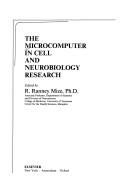| Listing 1 - 3 of 3 |
Sort by
|

ISBN: 044400842X 9780444008428 Year: 1985 Publisher: New York (N.Y.) : Elsevier,
Abstract | Keywords | Export | Availability | Bookmark
 Loading...
Loading...Choose an application
- Reference Manager
- EndNote
- RefWorks (Direct export to RefWorks)
Cytology --- Neurobiology --- Microcomputers --- Data processing --- Microcomputers. --- Data processing. --- Cytology - Data processing --- Neurobiology - Data processing
Book
ISBN: 1934115029 9786611927479 1281927473 1597454400 Year: 2009 Publisher: Totowa, NJ : Humana Press : Imprint: Humana,
Abstract | Keywords | Export | Availability | Bookmark
 Loading...
Loading...Choose an application
- Reference Manager
- EndNote
- RefWorks (Direct export to RefWorks)
The biological sciences are now in the midst of a true life sciences revolution akin to what physics experienced just after the turn of the last century. We are now in a phase of unparalleled growth that is reflected by the amount of data generated from each experiment. At the time of this writing, the rate of data acquisition was approaching 2 terabytes over the course of 5 days with first pass analysis proceeding over the following 2-3 week period. This fundamental shift has provided unprecedented opportunities that for the first time afford us the ability, i.e., means, breadth, and depth of data, to truly address human biology at the systems level. This wealth of information from seemingly disparate datasets and its integration is being realized through bioinformatics. It is with this philosophy that the text Bioinformatics for Systems Biology was born. This revolution has spawned true personalized medicine that encompasses diagnostics and treatment through to cure. For the physical and computer scientist, this text provides an introduction to the basic biological principles governing a cell. This quickly moves from the fundamentals to exploring the underlying genetic processes. While providing a rudimentary and necessary overview for the life scientist, the physical and computer scientist will be apprised of various nuances within the field reflecting the reality of "wet-bench" science. For those in the life sciences, it I rapidly becoming appreciated that we now progressing from examining our favorite "pet" gene to the system. Statistics is now an essential component to understand the vast datasets and this is emphasized throughout the text. The majority of the text is devoted to the common ground that these groups share. It provides rich examples of tools, databases, and strategies to mine the databases to reveal novel insights. A host of examples of parsing the data into a series of overlays that use various presentation systems are reviewed. The goal is to provide a representation most comfortable to the user to enable the user to thoroughly explore the data. The text concludes with examples of how the systems information is used to inform personalized medicine in a true "bench to bedside" manner. Bioinformatics for Systems Biology bridges and unifies many disciplines. It presents the life scientist, computational biologist, and mathematician with a common framework. Only by linking the groups together may the true life sciences revolution move forward in the mostly uncharted and emerging field of Systems Biology.
Bioinformatics. --- Computational biology. --- Cytology -- Data processing. --- Systems biology. --- Bioinformatics --- Computational biology --- Cytology --- Biology --- Biological Science Disciplines --- Natural Science Disciplines --- Disciplines and Occupations --- Computational Biology --- Health & Biological Sciences --- Biology - General --- Data processing --- Data processing. --- Bio-informatics --- Biological informatics --- Life sciences. --- Life Sciences. --- Information science --- Systems biology

ISBN: 0521254655 052127477X 9780521274777 Year: 1984 Publisher: Cambridge university press
Abstract | Keywords | Export | Availability | Bookmark
 Loading...
Loading...Choose an application
- Reference Manager
- EndNote
- RefWorks (Direct export to RefWorks)
Molecular biology --- Cytology --- Models, Biological --- Molecular Biology --- Models, Structural --- Mathematics --- Biologie moléculaire --- Cytologie --- Mathematical models --- Data processing --- Modèles mathématiques --- Informatique --- Models, Structural. --- Human biochemistry --- Models, Biological. --- Molecular Biology. --- Mathematics. --- Cell biology --- Cellular biology --- Biology --- Cells --- Cytologists --- Molecular biochemistry --- Molecular biophysics --- Biochemistry --- Biophysics --- Biomolecules --- Systems biology --- Data processing. --- Mathematical models. --- Molecular biology - Mathematical models --- Cytology - Mathematical models --- Molecular biology - Data processing --- Cytology - Data processing --- Molecular biology. --- Cytology. --- Biological models. --- Biologie moléculaire --- Modèles mathématiques. --- Informatique.
| Listing 1 - 3 of 3 |
Sort by
|

 Search
Search Feedback
Feedback About
About Help
Help News
News